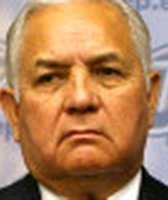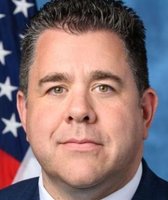Stand up for the facts!
Our only agenda is to publish the truth so you can be an informed participant in democracy.
We need your help.
I would like to contribute
Karl Rove says Republicans running in Texas draw 40 percent of Latino vote on average
Republican consultant Karl Rove thinks Georgia Republicans need to stump more like their Texas counterparts.
In a May 18, 2013, speech at Georgia’s GOP state convention, Rove said Republicans have "got to get outside of our comfort zone and go places Republicans are not comfortable going," according to a transcript provided to us by Atlanta Journal-Constitution reporter Daniel Malloy. "And we’ve got to get candidates who represent the diversity of our country," Rove said.
"Look, in Texas we get 40 percent of the Latino vote on average," Rove said. "And that’s because every Republican is comfortable campaigning everywhere in Texas and because we go out of our way to recruit qualified Latino candidates and run them for office."
Nationally in 2012, Barack Obama defeated Republican nominee Mitt Romney while enjoying substantial Latino support. Some 71 percent of Hispanic voters favored Obama, compared to 27 percent for Romney, according to voter exit polls undertaken for a consortium of news organizations. A Nov. 9, 2012, CNN news article quoted Republican strategist Ana Navarro, formerly a national Hispanic co-chair of Sen. John McCain's 2008 presidential campaign, as saying: "If we don't do better with Hispanics, we'll be out of the White House forever."
We wondered about Rove’s 40-percent-in-Texas claim.
Sign up for PolitiFact texts
Rove, best known for guiding George W. Bush to two wins for governor of Texas and two more for president, declined to elaborate.
Polling in 2012
Meantime, we noticed Texas Gov. Rick Perry earlier airing a similar claim, telling Politico for a Nov. 30, 2012, news article that about 40 percent of his state’s Hispanic voters had supported Bush for president and "me when I ran" for re-election as governor "in 2010."
Also, Mike Baselice, an Austin pollster who has counseled Perry and numerous Republican candidates, said in an October 2012 memo based on his firm’s Oct. 10-14, 2012, survey of 851 likely Texas voters that at that time, Obama had the support of 49 percent of the state’s Hispanic voters, with Romney at 40 percent. According to Baselice’s memo, Republican U.S. Senate nominee Ted Cruz was supported by 36 percent of Hispanic voters, while Democrat Paul Sadler had 40 percent.
The Politico story also mentioned a Texas poll taken on the eve of the 2012 elections indicating Cruz had 35 percent of the state’s Hispanic vote, outpacing Romney, who had 29 percent. The poll by Latino Decisions, a Seattle-based firm that specializes in Latino political opinion research, was based on 400 telephone interviews with Texas Latinos who had voted or were certain to vote. Its margin of error of plus or minus 4.9 percentage points suggests that Cruz, but not Romney, was on the verge of drawing 40 percent of the Latino vote.
We also talked to Steve Munisteri, chairman of the Republican Party of Texas, who said by phone that in December 2012, Wilson Perkins Allen Research polled 600 Latino Texas voters who participated in the 2012 elections. According to that research, conducted for the party and Republican officeholders, the party’s candidates at the top of the ticket drew more than 40 percent of the state’s Hispanic vote, Munisteri said, with statewide hopefuls farther down the ballot drawing about 35 percent.
James Henson, director of the Politics Project in the Department of Government at the University of Texas, struck a cautionary note as we explored Rove’s claim. Any look at how Latino voters divide relies on extrapolation, Henson reminded by email, "since there is no direct measure for Latino voting."
Besides, polls can be flawed, Democratic consultant James Aldrete of Austin said by telephone, sometimes under-sampling Hispanic voters or failing to query voters who wish to be interviewed in Spanish. Sylvia Manzano of Houston, an analyst for Latino Decisions, said by telephone that most polls of Texas Latinos fall short of achieving representative samples by concentrating, she said, on pockets of the state. She pointed out an October 2012 Latino Decisions blog post covering polling weaknesses in surveys taken before the 2012 elections.
Manzano said she would take Rove’s 40 percent claim with a grain of salt, though she also said "Latinos in Texas have not been averse to voting for Republicans" partly because the state’s Republican Party has not been hostile.
Texas polls since 2000
Kind of like stacking grains of salt, we focused on Texas Latino voters by reviewing more than a dozen poll results, covering seven elections from 2000 through 2012, as posted publicly or described to us by pollsters or partisans (see summary table below).
Upshot: The best a Republican fared with Texas Hispanics in the elections was U.S. Sen. Kay Bailey Hutchison when she drew half the Hispanic vote in 2000, by one analysis. The same year, Bush got 49 percent in his first run for president, according to that year’s exit polls taken for news organizations, or 33 percent, according to a poll by the William C. Velásquez Institute. Bush also drew 49 percent in 2004, according to the national exit poll. Joe Lenski, an executive with Edison Research, which oversaw the exit polling, told us by phone the margin of error on Bush’s share of the Latino vote in his home state was plus or minus seven percentage points.
By our look, the worst any Republican fared among Texas Hispanics was Romney’s election-eve 29 percent, according to the Latino Decisions poll. We set aside as an outlier Perry’s 31 percent of the Hispanic vote in 2006, considering Perry faced three major November foes, a Democrat and two independents.The same year in a more conventional race, Hutchison drew 44 percent of the Latino vote, according to that year’s exit poll.
Considering every result except the one for Perry in 2006 delivers an average of 39 percent of the Hispanic vote for Republicans at or near the top of the tickets. We also averaged the poll showings for each election year, reaching an across-the-years average of 40 percent. Trying another tack, we counted only the polled results for non-presidential candidates, also landing at 40 percent.
Three border counties
Next, we looked at how Republicans running statewide fared in 2010 and 2012 in traditionally Democratic and Latino-rich Cameron, Hidalgo and El Paso counties, which are on the Texas-Mexico border
Drawing on results posted online by the state, we found that in 2010, Attorney General Greg Abbott outpaced nine other GOP statewide winners, drawing 38 percent of the vote in Hidalgo County; 42 percent in El Paso County; and 48 percent in Cameron County. All the candidates together averaged 42 percent of the vote in Cameron County, 39 percent in El Paso County and 33 percent in Hidalgo County.
Aside from the presidential race, the 2012 Texas ballot had four statewide races pitting Republicans against Democrats. Cruz topped other GOP victors with 36 percent of El Paso County’s vote. Counting Romney, the GOP nominees carried an average of 27 percent of El Paso County’s vote; 28 percent in Hidalgo County; and 32 percent in Cameron County.
Wider views
Broadly, Aldrete suggested that since Republican divisions over immigration policy stirred many Latinos starting in 2006, Texas Republicans have experienced slippage among Hispanic voters, like Republicans nationally, he said. So we checked the average result across the available polls for Texas Republicans from 2008 through 2012: 37 percent.
By telephone, Baselice offered his historical perspective, saying that in 1982, in an era when Democrats usually won statewide elections, Texas Republicans seeking statewide office drew 12.5 percent of the Hispanic vote. Their share of the Hispanic vote in 1992 was 25 percent, Baselice said, and he then advised Rove that Bush would need 30 percent of the Hispanic vote to defeat Democratic Gov. Ann Richards in 1994.
Fast forward: In 2002, Baselice said, Perry carried 35 percent of the Hispanic vote in his first win for governor, and in 2010, he said, Perry got 36 percent of the Hispanic vote. The news organizations’ exit poll that November found Perry getting 38 percent of the Hispanic vote. The same year, Baselice said, David Dewhurst, the Republican re-elected lieutenant governor, drew 40 percent of the Hispanic vote while carrying 62 percent of the total vote. "You don’t get to the mid-60s" in overall percentage, Baselice said, "without getting a significant chunk of the Hispanic vote."
By email, New York pollster Micheline Blum, whose clients have included newspapers including the Austin American-Statesman, said by email: "While the majority of Latinos vote for Democrats in Texas as in other states, the Republican candidates for president and for governor have been averaging approximately 40" percent of the Texas Latino vote. "Candidates cannot afford to ignore the Latino vote in Texas—and they don’t," Blum wrote. "Also, Texas is more conservative than the country as a whole and Latino voters in Texas are a bit more conservative than in the country overall as well."
Our ruling
Rove said Republican candidates in Texas draw 40 percent of the Hispanic vote on average.
That claim holds up if you consider the limited array of public polls going back back to 2000, though polls taken in connection with the latest elections suggest not every Republican draws 40 percent. Perhaps there has been slippage since the immigration debate roiled anew and Bush stopped appearing on the ballot.
We rate the statement as Mostly True.
Snapshot: Texas Latino Support for Republicans
Year
Republican Candidate
Estimated Percentage of State's Latino Vote
Poll Source
2000
U.S. Sen. Kay Bailey Hutchison
50
William C. Velásquez Institute
2000
George W. Bush (for president)
49
National exit poll
2000
George W. Bush
32
William C. Velásquez Institute
2002
Gov. Rick Perry
35
Mike Baselice
2004
Bush
49
National exit poll
2006
Hutchison
44
National exit poll
2006
Featured Fact-check
Perry
31
National exit poll
2008
Sen. John Cornyn
36
National exit poll
2008
Sen. John McCain (for president)
35
National exit poll
2010
Perry
38
National exit poll
2010
Lt. Gov. David Dewhurst
40
Mike Baselice
2012
Mitt Romney (for president)
29
Latino Decisions
2012
Ted Cruz (for U.S. Senate)
35
Latino Decisions
2012
Romney
40
Mike Baselice
2012
Cruz
36
Mike Baselice
2012
Cruz
Low 40s
Wilson Allen Perkins Research
Sources: Poll of Hispanic voters, Texas, 2000, William C. Velásquez Institute; National exit polls, Texas results, 2010; 2008; 2006; 2004 (as posted on CNN.com and provided by Republican Party of Texas); telephone interview, Mike Baselice, Austin pollster; Latino Decisions "election eve" poll, November 2012; memo from Baselice, October 2012; and telephone interview, Steve Munisteri, chairman, Republican Party of Texas.
Our Sources
Excerpt, remarks by Karl Rove to Georgia Republican convention, May 18, 2013 (received by email from Daniel Malloy, Atlanta Journal-Constitution, May 29, 2013)
Commentary, Political Insider with Jim Galloway, "Your GOP convention jolt: Nathan Deal says feds 'dumping' refugees on Georgia," Atlanta Journal-Constitution, May 18, 2013
Poll, Latino Decisions, November 2012
Email, James Henson, director, Politics Project, Department of Government, University of Texas, May 30, 2013
National exit polls, Texas results, 2010; 2008; 2006; 2004 (as posted on CNN.com, 2004 results provided by Republican Party of Texas)
Texas Hispanic poll 2000, William C. Velásquez Institute (accessed May 30, 2013)
Telephone interview, Sylvia Manzano, senior analyst, Latino Decisions, Houston, May 31, 2013
Telephone interview, Mike Baselice, pollster, Austin, May 29, 2013
Memo, "Texas Survey of Likely Voters shows Romney and Cruz with Solid Leads," Mike Baselice, October 2012 (downloaded from Real Clear Politics website May 29, 2013)
Telephone interview, Joe Lenski, executive vice president, Edison Research, Somerville, New Jersey, May 30, 2013
Telephone interview, Steve Munisteri, chairman, Republican Party of Texas, Austin, May 31, 2013
Email (excerpted), Micheline Blum, director, Baruch College Survey Research, CUNY School of Public Affairs, May 31, 2013
Browse the Truth-O-Meter
More by W. Gardner Selby
Karl Rove says Republicans running in Texas draw 40 percent of Latino vote on average
Support independent fact-checking.
Become a member!
In a world of wild talk and fake news, help us stand up for the facts.
















































